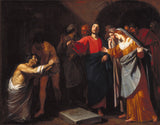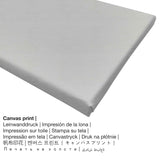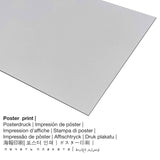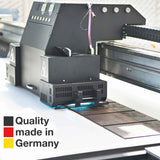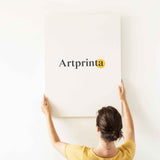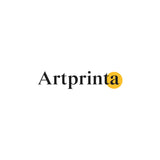Andrea Vaccaro, 1640 - Nzụlite Lazarọs - mbipụta nka mara mma
Ụtụ gụnyere. Mbupu gbakọrọ na ndenye ọpụpụ.
Kedu ihe eji ebipụta nka mara mma m nwere ike ịhọrọ?
Maka mbipụta nka ọ bụla anyị na-enye ihe dị iche iche & nha. Ị nwere ike ịhọrọ n'ime nhọrọ nhazi ngwaahịa ndị a:
- Mbipụta kanvas: The canvas print, which should not be confused with a painting on a canvas, is an image printed from an industrial printing machine. It makes the special effect of three-dimensionality. A printed canvas of your favorite work of art will let you turn your very own fine art print into a large collection piece. Canvas prints are relatively low in weight, which means that it is easy to hang up the Canvas print without any wall-mounts. Canvas prints are suited for any kind of wall.
- Mbipụta enyo acrylic: A glossy acrylic glass print, often denoted as a plexiglass print, will convert the original artwork into brilliant home décor. The artwork is being printed thanks to the help of modern UV direct print machines.
- Akwụkwọ mmado na ihe kwaaji: Our poster print is a printed flat canvas with a slightly rough texture on the surface. The poster print is best suited for putting your art copy in a personal frame. Please note, that depending on the absolute size of the canvas poster print we add a white margin of around 2 - 6cm around the artwork, which facilitates the framing with a custom frame.
- Metal (aluminium debond mbipụta): Aluminium Dibond prints are metal prints with an outstanding depth effect. The non-reflective surface structure creates a modern look. For our Direct Print On Aluminum Dibond, we print your selected artpiece right onto the aluminium composite white-primed surface.
Ozi dị mkpa: We try whatever we can to describe our products with as many details as possible and to illustrate them visually in our shop. Nonetheless, the pigments of the printed materials, as well as the printing might diverge to a certain extent from the presentation on the monitor. Depending on the screen settings and the nature of the surface, not all colors will be printed as exactly as the digital version. Given that the art prints are printed and processed manually, there might also be slight variations in the size and exact position of the motif.
Ozi nka nka izizi sitere na webụsaịtị ihe ngosi nka (© - site na Indianapolis Museum of Art - www.discovernewfields.org)
Oil on canvas, 20-1/2 x 26-5/8 in
Indianapolis Museum of Art Delavan Smith Fund
Gallery label: This scene represents the miracle that marked the culmination of Christ's ministry on earth. He raises his hand and commands Lazarus to rise from his tomb: "Lazarus, come forth." The dead man, still wrapped in his shroud, clasps his hands together in a gesture that registers his recognition of Christ's divinity. The miracle foreshadows Christ's own resurrection. Vaccaro's works are distinguished not only by their assimilation of Caravaggio's strong contrasts of light and dark, but by their classical restraint and gravity of expression. The latter traits derive from the Bolognese master, Guido Reni.
Ihe nka nwere aha "Mbilite n'ọnwụ Lazarọs"dị ka mbipụta nka nke gị
Na 1640 onye na-ese ihe Andrea Vaccaro painted the baroque masterpiece with the title Mbilite n'ọnwụ Lazarọs. Moveover, the artwork belongs to the Indianapolis Museum of Art's digital collection, which is one of the finest universal art museums that has an extensive collection of art history from different eras with objects from all parts of the world.. With courtesy of: Indianapolis Museum of Art (license - public domain).: . On top of that, alignment of the digital reproduction is in odida obodo format na akụkụ ruru nke 4: 3, which means that the length is 33% longer than the width. Andrea Vaccaro was a engineer of Italian nationality, whose artistic style can be attributed mainly to Baroque. The Italian artist lived for 100 afọ, amuru na 1732 ma nwụọ na 1832.
Data nka ahaziri
| Aha nke ihe nka: | "Mbilite Lazarọs" |
| Nhazi nka: | sere |
| Otu izugbe: | nka ochie |
| Time: | 17th narị afọ |
| Emepụtara na: | 1640 |
| Afọ nka: | ihe karịrị afọ 380 |
| Ụlọ ihe ngosi nka / ebe: | Analọ ihe nkiri nka nke Indianapolis |
| Ebe ngosi nka: | Indianapolis, Indiana, Njikota Obodo Amerika |
| Dị n'okpuru: | Analọ ihe nkiri nka nke Indianapolis |
| Ikikere nke ihe osise: | ngalaba ọha |
| Site n'aka: | Analọ ihe nkiri nka nke Indianapolis |
Ngwaahịa a
| Nkewa ngwaahịa: | ọmarịcha nka |
| Usoro mmeputakwa: | dijitalụ mmeputakwa |
| Usoro mmepụta: | Mbipụta UV ozugbo |
| Mmalite nke ngwaahịa a: | arụpụtara na Germany |
| Ụdị ngwaahịa: | mmepụta ihe na-achọ |
| A na-atụ aro iji ngwaahịa eme ihe: | Ụlọ ihe ngosi nka, mgbidi gallery |
| Nhazi nka nka: | usoro odida obodo |
| Ụdị anya: | ogologo ruo obosara 4: 3 |
| Oke akụkụ pụtara: | ogologo bụ 33% ogologo karịa obosara |
| Ụdị ngwaahịa dị iche iche: | Mbipụta kwaaji, mbipụta enyo acrylic (nwere ezigbo mkpuchi iko), mbipụta akwụkwọ mmado (akwụkwọ kwaaji), mbipụta ọla (aluminium dibbond) |
| Mbipụta kanvas (akwa akwa na etiti ihe ndọtị): | 40x30cm - 16x12", 80x60cm - 31x24", 120x90cm - 47x35", 160x120cm - 63x47" |
| Mbipụta iko acrylic (nwere ezigbo mkpuchi iko) nhọrọ nha: | 40x30cm - 16x12", 80x60cm - 31x24", 120x90cm - 47x35" |
| Mpempe akwụkwọ mmado (akwụkwọ kwaaji) nha dị iche iche: | 40x30cm - 16x12", 80x60cm - 31x24", 120x90cm - 47x35" |
| Nhọrọ nha nha nke Dibond (ihe alumnium): | 40x30cm - 16x12", 80x60cm - 31x24", 120x90cm - 47x35" |
| Nhazi nke nnomi nka: | enweghị etiti |
Data omenka ahaziri ahazi
| Ihe nkiri: | Andrea Vaccaro |
| Aha ndị ọzọ: | Andrea Vaccaro, Vaccaro Andrea |
| okike nke onye nka: | nwoke |
| Obodo onye nka: | Italian |
| Ọrụ: | engineer |
| Obodo obibi: | Italy |
| Nhazi nke onye nka: | nna ukwu ochie |
| styles: | Baroque |
| Akwụsị: | 100 afọ |
| Amụrụ n'afọ: | 1732 |
| Nwuru: | 1832 |
Edobere ederede a site na nwebisiinka © , Artprinta.com

